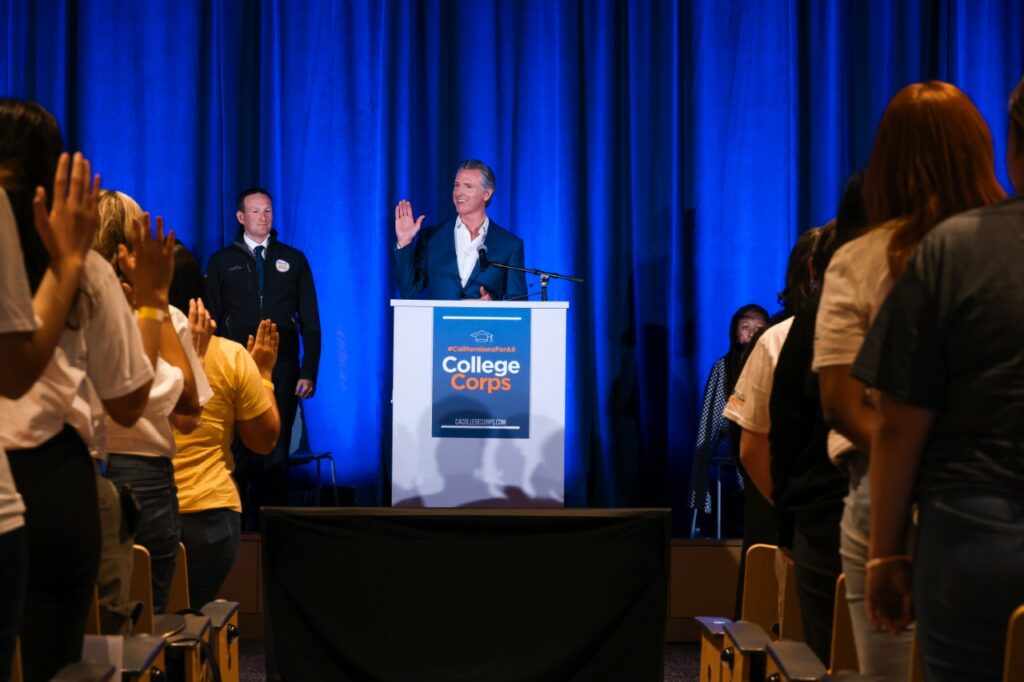
Gov. Gavin Newsom joins Chief Service Officer Josh Fryday and higher education leaders at a College Corps swearing-in celebration.
Credit: Office of the Governor
In 2022, the state launched the #CaliforniansForAll College Corps program. Spread across 45 campuses throughout the state, the program is designed to help college students pay for their schooling in exchange for performing community service: It offers $10,000 for 450 hours of service, paid through 10 monthly installments of $700 and an additional $3,000 for completing the program.
This new program is well-intentioned, but there is room for improvement.
I joined College Corps during its inauguration, under the regional chapter — Sacramento Valley College Corps, formed by California State University, Sacramento; UC Davis; Sacramento City College and Woodland Community College. After completing the application to be a fellow beginning in the summer, I was paired with a host site almost immediately. My placement was with First Star Sacramento State Academy, a college-preparation program aimed at helping high school students within the foster care system graduate and go to college. This help was provided through the tutoring and resources offered by youth mentors, which was my position at First Star.
Prior to my admission into College Corps, I was already an employee of First Star; the director of the program worked with College Corps to ensure I got placed there. But I took on a new role: College Corps fellow.
This meant I was no longer a student assistant working only 10 hours a week. Now I was expected to work almost double that as a fellow, and my responsibilities grew.
My experience with First Star as a youth mentor was wonderful. I already knew the program and the students in it. I had an established relationship with the supervisor, program coordinator and director. It was working under College Corps where challenges arose.
After completing one year with College Corps at First Star, I re-enrolled in the program as part of its second cohort. My new host site was Girl Scouts Heart of Central California. Since it was located only seven minutes from my campus, I thought this was going to be a great match.
Unfortunately, the job required going from city to city, and I do not own a car, so I had to withdraw from the program only one month in. In addition, my supervisor expected us fellows to complete some of our hours in the Modesto office, nearly a 1.5-hour commute. (I learned that right after I left, the remaining fellows were given rental cars to complete their hours.)
Another problem was that many Girl Scout events took place in the evening, since they were after-school activities for the girls. As a full-time student taking mostly evening classes, I struggled to fulfill my hours as the opportunities to do so were either far away, or at a time I was in class, or both.
Since I was part of the very first cohort of the College Corps, it is understandable that my experience was not entirely smooth.
For starters, there seemed to be a disconnect with College Corps and the external host sites. Fellows at some placements struggled to complete the required hours because host sites simply didn’t have enough service opportunities. This was a real problem because failure to complete the required hours put College Corps fellows at risk of losing the $3,000 education award promised to them upon completion.
Another challenge was the payment method. We were paid via a prepaid debit card that was quite cumbersome to use. I also had problems receiving my $3,000 education award.
Thankfully, College Corps ditched the prepaid cards in the second year and now pays fellows via simple checks, although direct deposit is still not available for the second cohort.
Yesenia Toribio, a Sacramento State student and former College Corps fellow, acknowledged the positives of the program. “I felt very supported by my supervisor at my host site and the staff in charge of leading the cohort for College Corps at Sacramento State. Everyone was so patient and understanding, it made me feel like I was a part of something bigger.
“I truly believe the downsides were because we were the first cohort and they were still trying to figure out the program,” Toribio said.
However, she added, “It was difficult trying to manage completing 450 hours of community service while being a full-time student and working part time.”
But, despite the growing pains, I can still see the promise and potential of the College Corps. Being part of it provided us with many benefits — not just monetary. The program allowed fellows to get involved with different events such as feeding the homeless, runs, river cleanups and more. The program also allowed fellows to make connections, and I still consider the fellow youth mentors at First Star as my close friends.
●●●
Aya Mikbel is a fourth-year student studying political science and journalism at California State University, Sacramento and a member of EdSource’s California Student Journalism Corps.
The opinions in this commentary are those of the author. If you would like to submit a commentary, please review our guidelines and contact us.

